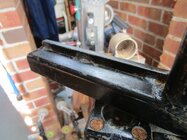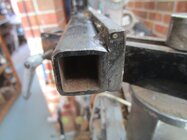My shop has a mix of engineering and wood orientated tools, which leads me all over the place at times .
This time to fabricated tool rests and a interesting discovery, that these tool rests act like cast iron tool rests in so much as they absorb vibration. When I first started out I had a cheap Chinese knock lathe with cast iron tool rests. Tool rests that were thin on the wings, ideal for poking down inside when hollowing. Yup I broke the wings off, welded them back on a couple of times, but it was obvious that this couldn't continue. The bowls I was turning got bigger and bigger, allowing the tool rest to go further and further into the vessel.
So came up with fabricated tool rests as simple and cost effective , over the years I have made many and as I changed lathes most went out with the lathe. The beauty of it is any short lengths of flat bar or SHS will do fine, and if curved is required or some other shape, again no problems. With curved etc you will have to bend the individual pieces prior to welding This one is a small 8" straight rest a mix of SHS and flat bar with heavy tack welds. Fully welding may induce all sorts of unwanted curves and twists as it cools down, too date I have never had a welding failure.
This time to fabricated tool rests and a interesting discovery, that these tool rests act like cast iron tool rests in so much as they absorb vibration. When I first started out I had a cheap Chinese knock lathe with cast iron tool rests. Tool rests that were thin on the wings, ideal for poking down inside when hollowing. Yup I broke the wings off, welded them back on a couple of times, but it was obvious that this couldn't continue. The bowls I was turning got bigger and bigger, allowing the tool rest to go further and further into the vessel.
So came up with fabricated tool rests as simple and cost effective , over the years I have made many and as I changed lathes most went out with the lathe. The beauty of it is any short lengths of flat bar or SHS will do fine, and if curved is required or some other shape, again no problems. With curved etc you will have to bend the individual pieces prior to welding This one is a small 8" straight rest a mix of SHS and flat bar with heavy tack welds. Fully welding may induce all sorts of unwanted curves and twists as it cools down, too date I have never had a welding failure.


